Fiberglass insulation stands as a stalwart guardian, protecting homes and buildings against temperature fluctuations and sound transmission. However, its efficacy can be compromised when subjected to moisture, leading to a litany of issues ranging from reduced thermal efficiency to mold proliferation. Understanding the signs of moisture damage and the subsequent remedial actions is paramount for maintaining the integrity of insulation.
Detecting Moisture Damage:
- Visual Inspection: Start by visually assessing the insulation. Visible signs of moisture damage include discoloration, sagging, or clumping of the fiberglass material. Discoloration, often yellow or brown patches, can indicate water absorption and subsequent drying.
- Odor: A musty or damp odor in the vicinity of the insulation may signal moisture infiltration, hinting at potential mold growth.
- Temperature Variations: Inconsistencies in indoor temperature regulation despite insulation presence might indicate compromised insulation due to moisture saturation.
- Condensation: Condensation forming on windows or walls near the insulated area may signify excessive moisture within the walls where the insulation resides.
- Mold Growth: Visible mold growth on or near the insulation material is a clear indicator of moisture damage.
Responding to Moisture-Damaged Fiberglass Insulation:
- Identify the Source: Trace and rectify the source of moisture. This could involve repairing leaks in plumbing, addressing roof leaks, improving ventilation, or fixing gaps that allow moisture intrusion.
- Remove Affected Insulation: Damaged sections of insulation should be removed promptly to prevent further moisture retention and mold proliferation. Ensure proper safety measures, such as wearing protective gear, as disturbed insulation may release particles.
- Drying and Dehumidification: Allow the affected area to dry thoroughly. Use dehumidifiers and fans to expedite the drying process. Ensure proper ventilation to prevent moisture buildup in the future.
- Sanitization and Remediation: If mold growth is present, it’s crucial to sanitize the area. Use appropriate mold remediation techniques or seek professional assistance to ensure complete removal.
- Replace Insulation: Once the affected area is thoroughly dried and sanitized, replace the damaged insulation with new material. Ensure the installation adheres to recommended standards and addresses the identified moisture sources.
- Preventative Measures: Implement measures to prevent future moisture damage, such as improving ventilation, installing vapor barriers, or sealing gaps and cracks in the building envelope.
Consulting Professionals:
In cases of extensive damage, persistent moisture issues, or mold infestations, consulting professionals, such as insulation contractors or remediation experts, is advisable. Their expertise can help in assessing the extent of damage and executing comprehensive solutions to restore insulation efficacy and prevent reoccurrence.
In essence, vigilant observation and prompt action are pivotal in addressing moisture damage to fiberglass insulation. By swiftly identifying, rectifying, and remedying moisture-related issues, homeowners and building managers can uphold the efficiency and longevity of their insulation, ensuring a well-insulated and healthy living or working environment.

